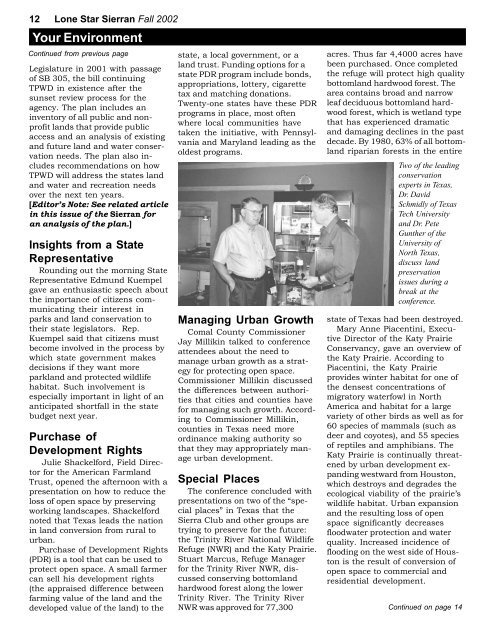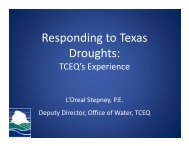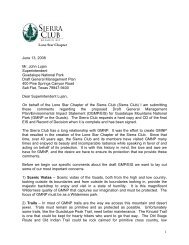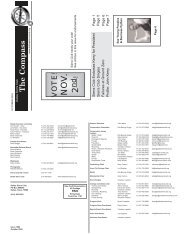Fall 2002 - Lone Star Chapter, Sierra Club
Fall 2002 - Lone Star Chapter, Sierra Club
Fall 2002 - Lone Star Chapter, Sierra Club
Create successful ePaper yourself
Turn your PDF publications into a flip-book with our unique Google optimized e-Paper software.
12 <strong>Lone</strong> <strong>Star</strong> <strong>Sierra</strong>n <strong>Fall</strong> <strong>2002</strong><br />
Your Environment<br />
Continued from previous page<br />
Legislature in 2001 with passage<br />
of SB 305, the bill continuing<br />
TPWD in existence after the<br />
sunset review process for the<br />
agency. The plan includes an<br />
inventory of all public and nonprofit<br />
lands that provide public<br />
access and an analysis of existing<br />
and future land and water conservation<br />
needs. The plan also includes<br />
recommendations on how<br />
TPWD will address the states land<br />
and water and recreation needs<br />
over the next ten years.<br />
[Editor’s Note: See related article<br />
in this issue of the <strong>Sierra</strong>n for<br />
an analysis of the plan.]<br />
Insights from a State<br />
Representative<br />
Rounding out the morning State<br />
Representative Edmund Kuempel<br />
gave an enthusiastic speech about<br />
the importance of citizens communicating<br />
their interest in<br />
parks and land conservation to<br />
their state legislators. Rep.<br />
Kuempel said that citizens must<br />
become involved in the process by<br />
which state government makes<br />
decisions if they want more<br />
parkland and protected wildlife<br />
habitat. Such involvement is<br />
especially important in light of an<br />
anticipated shortfall in the state<br />
budget next year.<br />
Purchase of<br />
Development Rights<br />
Julie Shackelford, Field Director<br />
for the American Farmland<br />
Trust, opened the afternoon with a<br />
presentation on how to reduce the<br />
loss of open space by preserving<br />
working landscapes. Shackelford<br />
noted that Texas leads the nation<br />
in land conversion from rural to<br />
urban.<br />
Purchase of Development Rights<br />
(PDR) is a tool that can be used to<br />
protect open space. A small farmer<br />
can sell his development rights<br />
(the appraised difference between<br />
farming value of the land and the<br />
developed value of the land) to the<br />
state, a local government, or a<br />
land trust. Funding options for a<br />
state PDR program include bonds,<br />
appropriations, lottery, cigarette<br />
tax and matching donations.<br />
Twenty-one states have these PDR<br />
programs in place, most often<br />
where local communities have<br />
taken the initiative, with Pennsylvania<br />
and Maryland leading as the<br />
oldest programs.<br />
Managing Urban Growth<br />
Comal County Commissioner<br />
Jay Millikin talked to conference<br />
attendees about the need to<br />
manage urban growth as a strategy<br />
for protecting open space.<br />
Commissioner Millikin discussed<br />
the differences between authorities<br />
that cities and counties have<br />
for managing such growth. According<br />
to Commissioner Millikin,<br />
counties in Texas need more<br />
ordinance making authority so<br />
that they may appropriately manage<br />
urban development.<br />
Special Places<br />
The conference concluded with<br />
presentations on two of the “special<br />
places” in Texas that the<br />
<strong>Sierra</strong> <strong>Club</strong> and other groups are<br />
trying to preserve for the future:<br />
the Trinity River National Wildlife<br />
Refuge (NWR) and the Katy Prairie.<br />
Stuart Marcus, Refuge Manager<br />
for the Trinity River NWR, discussed<br />
conserving bottomland<br />
hardwood forest along the lower<br />
Trinity River. The Trinity River<br />
NWR was approved for 77,300<br />
acres. Thus far 4,4000 acres have<br />
been purchased. Once completed<br />
the refuge will protect high quality<br />
bottomland hardwood forest. The<br />
area contains broad and narrow<br />
leaf deciduous bottomland hardwood<br />
forest, which is wetland type<br />
that has experienced dramatic<br />
and damaging declines in the past<br />
decade. By 1980, 63% of all bottomland<br />
riparian forests in the entire<br />
Two of the leading<br />
conservation<br />
experts in Texas,<br />
Dr. David<br />
Schmidly of Texas<br />
Tech University<br />
and Dr. Pete<br />
Gunther of the<br />
University of<br />
North Texas,<br />
discuss land<br />
preservation<br />
issues during a<br />
break at the<br />
conference.<br />
state of Texas had been destroyed.<br />
Mary Anne Piacentini, Executive<br />
Director of the Katy Prairie<br />
Conservancy, gave an overview of<br />
the Katy Prairie. According to<br />
Piacentini, the Katy Prairie<br />
provides winter habitat for one of<br />
the densest concentrations of<br />
migratory waterfowl in North<br />
America and habitat for a large<br />
variety of other birds as well as for<br />
60 species of mammals (such as<br />
deer and coyotes), and 55 species<br />
of reptiles and amphibians. The<br />
Katy Prairie is continually threatened<br />
by urban development expanding<br />
westward from Houston,<br />
which destroys and degrades the<br />
ecological viability of the prairie’s<br />
wildlife habitat. Urban expansion<br />
and the resulting loss of open<br />
space significantly decreases<br />
floodwater protection and water<br />
quality. Increased incidence of<br />
flooding on the west side of Houston<br />
is the result of conversion of<br />
open space to commercial and<br />
residential development.<br />
Continued on page 14







